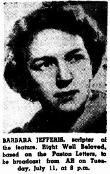The daughter of Lucy Barbara Ingoldsby (Smythe) and Tarlton Jefferis, Barbara Jefferis was educated at Riverside in Adelaide and then began a Bachelor of Arts at the University of Adelaide. In 1939, she married John Hamilton Hinde, a film critic for the ABC. She moved to Sydney in her twenties and worked in daily and magazine journalism, then as a freelance radio writer. Jefferis wrote more than 50 radio dramas and dramatised documentaries as well as serials, scientific and educational programmes. She was a regular reviewer for The Sydney Morning Herald and The Australian. Her novels have been widely translated into European and Asian languages.
Jefferis was the first woman President of The Australian Society of Authors (ASA), serving three terms (1973-1976), and was a force in writers' politics from the time the society began in the 1960s. She was a member of the ASA executive from 1973 onwards, with particular interests in publishing contracts and Public Lending Right (PLR). Jefferis represented writers' interests on the Government's PLR committee fron 1979-1985; the last year as Acting PLR Chairman. She held the ASA's PLR portfolio from 1981-1989 and held the ASA's Contract Advisory Service portfolio from its inception.
Jefferis made cultural exchange visits to Russia, India and Canada.
The Barbara Jefferis Award for the best novel written by an Australian author that depicts women and
girls in a positive way or otherwise empowers the status of women and
girls in society was created in 2007 after being endowed by Jefferis's husband of sixty-four years John Hinde upon his death.
 439869955866949398.jpg
439869955866949398.jpg